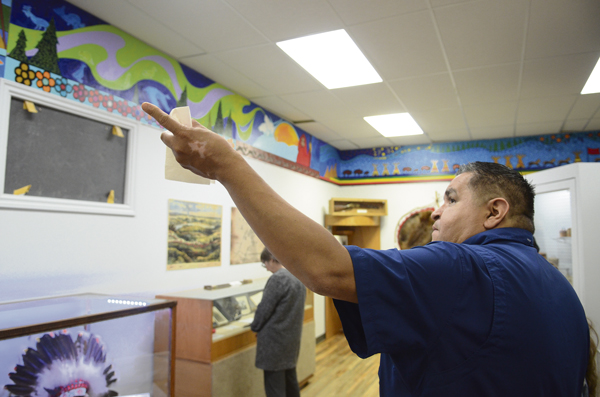
Leah Dorion remembers going the Prince Albert Historical Museum, and to Lund’s Wildlife Exhibit, a lot when she was a child.
“We used to come here to look at stuff. I remember not really seeing myself, or my culture.”
Dorion, a Métis artist, helped design several panels unveiled at the museum Friday that are part of an effort by the historical society to better represent the history of the region’s Indigenous people.
The museum unveiled murals that now adorn the wall in what will become a space dedicated to the history of the Indigenous people of the Prince Albert area. The murals were designed by artists Leah Dorion and Kevin Pee-Ace and painted with assistance from the community. According to the museum, about 250 people, including students from King George elementary school, assisted in the creation of the murals.
The murals are designed as a set of panels, which, mostly, flow from one to the other. Dorion designed panels to tell the story of the local English Métis, while the work done by Pee-Ace depicts the histories of various First Nations groups, including the plains, woodland and Swampy Cree, Dakota and Dene people.
The plan is to install new exhibition panels below the panels that correlate to each respective Indigenous group. That knowledge has already been gathered. As part of the first phase of the project, the museum met with Indigenous knowledge keepers to develop the information they need to put the artifacts into the correct context.
“I think it’s amazing,” museum curator Michelle Taylor said.
‘it turned out better than expected”
The artists themselves are also pleased with how the project turned out.
“I want to acknowledge everyone who had a hand (making these),” she said. “There is just so much work that goes into telling a new story.”
Pee-Ace wasn’t sure exactly how the work would turn out, but he walked away with a new appreciation of the process and some of the histories of the many First Nations groups in the area.
‘It was a big learning process for me,” he said.
“There was a lot of history that I didn’t know in Prince Albert. I’ll be honest with you. I’m still learning. I don’t know a lot about the cultural histories of the people who were in the Prince Albert area, but being called in, from the perspective of an artist, when yore working with ideas, the main thing is to put them together so they can fit and work together.
“I was happy to be part of it because if I hadn’t done the project, there would be a lot of things I wouldn’t have known. You have to go into it with an open mind.”
Now, the museum’s focus is on creating new exhibits that will fill the space. The information for the new displays came out of a consultation done with Indigenous elders.
“Knowledge keepers came together and provided information about their groups so I could put that information together into a display panel,” Taylor said. (They) are the basis for a lot of the display panels that will go in here.”
Some of the artifacts in the museum’s collection are reflected in the artwork. That includes beadwork patterns used in the paintings and some historical objects. For instance, the Dakota panel has an image of a medal given to honour the group’s efforts in the war of 1812. The museum has a replica of that medal. The work re-curating that section of the museum is set for a Fall 2020 completion date.
“Everyone is very happy to see that we are finally acknowledging our Indigenous community in the museum. For far too long we were a European settlement museum, with a large indigenous collection but not well explained,” Taylor said.
“Now, with this room, we hope to explain and make everyone aware of the impact the First Nations and Métis had on the development of Prince Albert.”
For Dorion, seeing that recognition of Indigenous cultures brings joy.
“I’m so happy that kids today can see First Nations and Métis culture and other people’s culture,” she said. “Those murals will be there for a very long time.”

